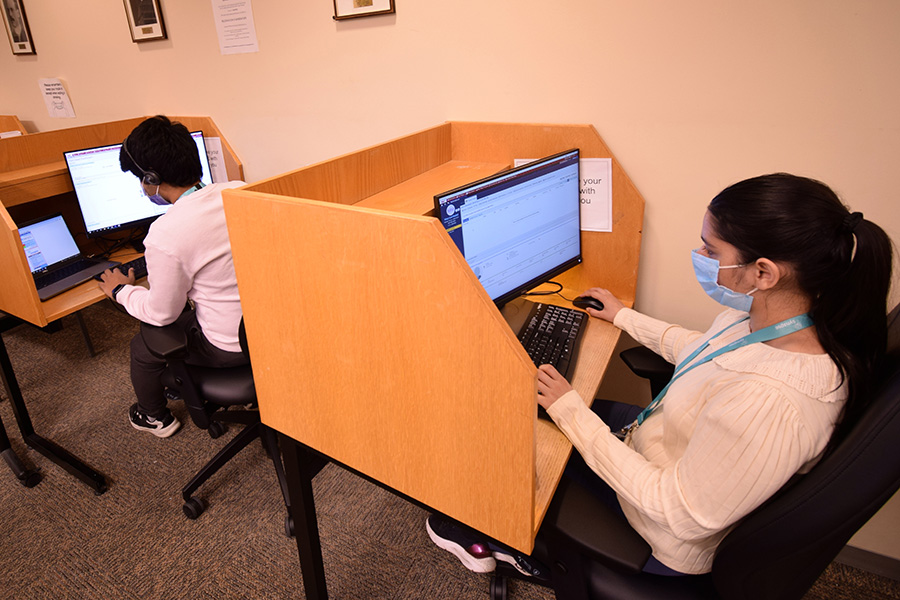Synapse training is instructor-led, but it’s delivered through meetings on MS Teams instead of more traditional classroom instruction. (Photo: UHN)
Ivana Frighetto admits the task at the outset seemed daunting – 25 hours of training on University Health Network’s new health information system (HIS) spread over four virtual sessions in a few weeks.
But looking back midway through her training, Ivana, a medical administrative assistant to four physicians in the Toronto General Hospital site of UHN’s Centre for Mental Health, is feeling reassured.
“It’s been a very friendly environment,” says Ivana, who has been with UHN since 1997. “The instructors go at a really good pace, you don’t feel silly asking a question and they repeat themselves multiple times to make sure everyone is on the same page.”
Ivana is one of more than 13,000 end users at UHN being trained over two months on the new HIS from Epic, which will be implemented on June 4. The project is code-named Synapse to symbolize the interconnections created when there’s a single source of truth about each patient’s medical journey.
Planning of the education and training program for Synapse began in late 2020, months into the pandemic. With the success of digital education to that point, and the uncertainty of how COVID would look when training had to start in March 2022, it was decided training would be completely virtual.
“Given that we didn’t know what was happening with COVID and that we’re now in a Sixth Wave, there are no plans to shift away from virtual training to in-person,” says David Wiljer, Executive Director of Education, Technology & Innovation at UHN. “The plan has been to focus on how do we learn, how do we support, how do we adjust, take in data and move forward to be even better.”
Synapse education and training has been another example of the ability at UHN to respond to the pandemic quickly and with innovation. Training is instructor-led, but it’s delivered through meetings on MS Teams instead of more traditional classroom instruction.
The instructors are mostly people from within UHN with workflow expertise who sought out the temporary assignment. They underwent their own extensive virtual training to become credentialed in delivering training on the Epic system.
The new HIS is comprehensive and access to it is role-based. That means the screens and fields seen, for example, by a nurse in the operating room differ from a nurse on a cardiology unit because their workflows are different.
It follows that the curricula for Epic training have also had to be comprehensive and role-based.

“The training is extensive and detailed because we want people to be as comfortable and confident in the system so they can focus on the patient,” says Ivanka Hanley, Senior Manager of Education and Training for Synapse.
One of the challenges for Ivanka and her team has been making the TeamUHN members in the sessions not feel alone despite the virtual delivery. That’s meant trying to continuously improve the program by gathering feedback quickly and applying lessons learned.
One challenge was to ensure everyone who needs the Synapse training has access to a computer that meets software requirements. While staff could take the training from home, not everyone has the necessary equipment or an environment where they could concentrate on learning.
The solution was for the team to build a temporary and flexible support structure to make individualized tech-prep support available, and block off computer labs at each site for those who didn’t have a suitable computer at work or home.
“It’s been important for us to pay attention to any concerns raised by students and adapt,” Ivanka says.
Ivana Frighetto, who has another Synapse training session this week and her final one near the end of May, says despite the large volume of material to cover, the fast pace and having to toggle back and forth between course work and the instructors because she only has one computer screen, the sessions have been “really useful” and she appreciates it “being specifically geared to my role.”
In addition to the “amazing” instructors, Ivana has found short videos that come with each MS Teams invite very helpful preparation, as are the exercises to do in the “playground” during training sessions.
“It’s positive reinforcement that really reduces the stress,” she says.
Sarah Muttitt, Vice President and UHN Chief Information Officer, believes others will emulate this work.
“This really is pioneering,” she says. “I have no doubt when we get through our virtual training that it will become part of core curriculum training for Epic at other sites.”
Sarah added that even if the pandemic hadn’t forced the decision to take training virtual, “it would have been a major logistical challenge” to get 13,000 people trained in-person in two months.
“Virtual training is the way of the future,” she says. “It allows us to continue to train people on a regular basis versus gathering them into classrooms.”



